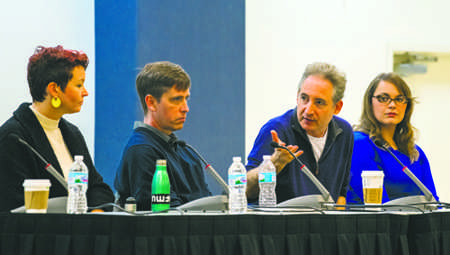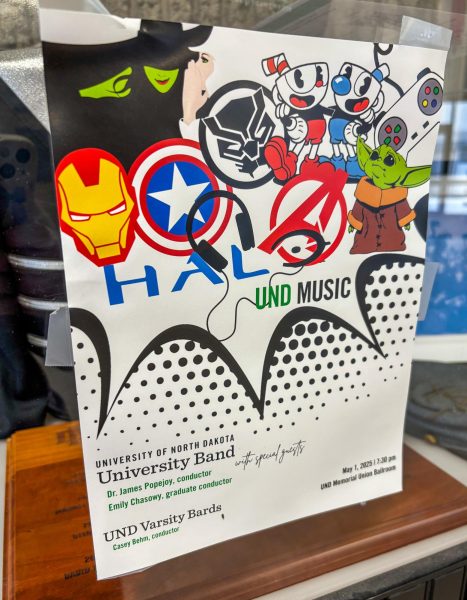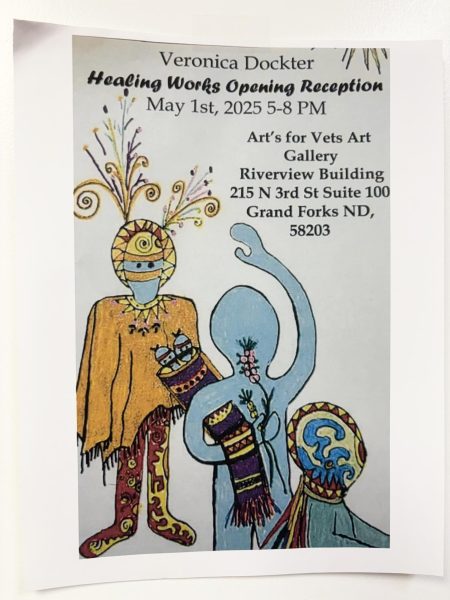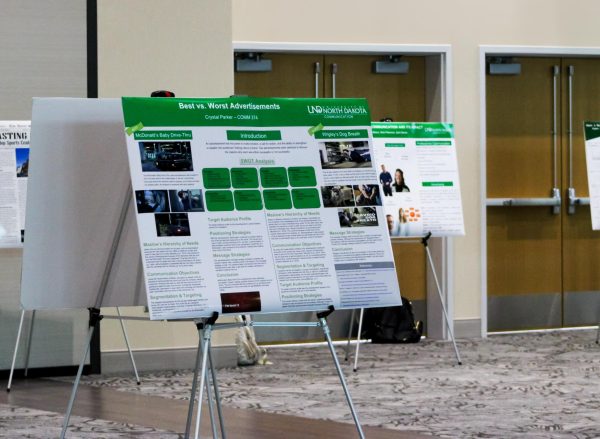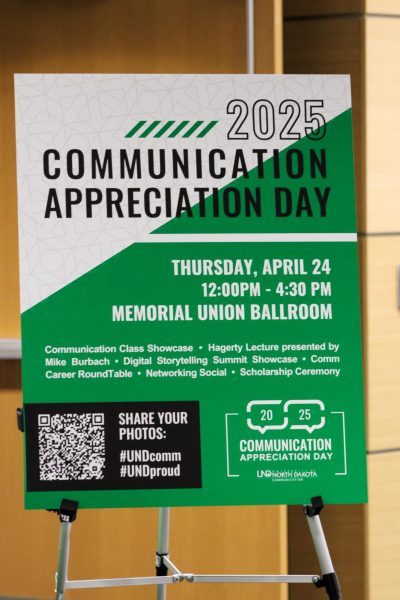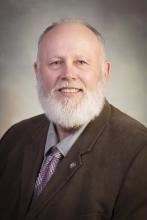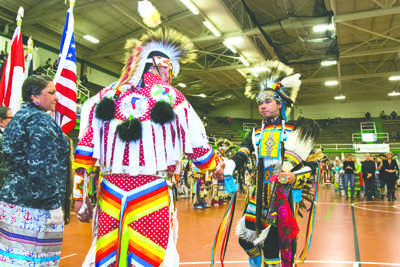Art and science converge at UND
Author and physicist Brian Greene (right) addresses fellow panelists Frank Huyler and Allison Leigh Holt at the 47th annual UND Writers Conference. The theme of the panel was “Other Worlds.” Photo by Nick Nelson/The Dakota Student.
Art. Science. Cosmic bubble bath. These are just a few of the topics talked about at the 47th annual UND Writers Conference.
The conference, which took place over three days last week, brought five authors and one visual artist to Grand Forks to explore this year’s theme, “The Art of Science.”
The authors were selected for their incorporation of science into their work.
The free event featured readings by the authors, an art installation from Allison Leigh Holt at the North Dakota Museum of Art, workshops and panels.
Other Worlds
Thursday’s panel, titled “Other Worlds,” featured Brian Greene, Kim Stanley Robinson Allison Leigh Holt and Frank Huyler.
The panel was moderated by UND English professor Sheila Liming, who began the session by asking the panelists, “What is the closest that you think you have ever come in your work to experience or engaging with what you would call another world?”
Greene was the first to respond, talking about his work as a physicist and the math that suggests our universe is just one of many.
“Right there in the equations you see that our universe might have emerged from one Big Bang,” Greene said. “But there could be many Big Bangs, each one giving rise to a different expanding realm, a kind of big, grand cosmic bubble bath where our universe is just one bubble among the many.”
Greene described a game of “quantum Russian roulette,” in which the player dies in one universe but wins $1 million in each of five other universes.
Though the math is there, Greene admitted he wouldn’t play the game, eliciting laughter from the crowd.
Kim Stanley Robinson said his experience with other worlds is internal. The science fiction author described his genre as “thought exercise.”
Whether it’s imagining an alternative history, time travel or the future, Robinson said science fiction is all about other worlds. In his award-winning Mars trilogy, Robinson imagines life on the Red Planet.
Holt, the conference’s sole visual artist, said she experienced another world on Earth while living in Indonesia.
By studying consciousness and traditional knowledge — a deep understanding of local environments in indigenous people — Holt said she learned that our histories affect the way we experience our surroundings.
“Indigenous peoples are, by their definition, existing in a different world, in another world,” Holt said. “This is one other world that we can consider, absolutely.”
The Butterfly Effect
Friday’s panel featured Huyler, Katharine Coles and Tania James. UND English professor Heidi Czerwiec moderated, leading the discussion on the butterfly effect, the idea that small changes can lead to large consequences.
Huyler said that as a writer, he has seen a single thought evolve into something bigger. He shared an example of how seeing an injured girl after an earthquake in northern Pakistan eventually turned into one of his novels.
“Often you’ll have a single scene — or an image or something like that — that then sort of spawns something much greater,” Huyler said. “It’s how our minds work, I think, as writers.”
James referred to her early years as a writer and the events that led to her to where she is today.
As an Indian-American teenage girl, James said she didn’t think she met the criteria for becoming a writer. She said her idea of what a writer looked like changed when she met two black writers, a combination she didn’t know existed. The writers became her teachers, and the first lesson she learned was that not all writers looked the same.
“The only writers I had ever read were white, mostly men and mostly dead,” James said. “It felt like this moment where just this small episode, this small meeting, kind of led to me thinking about larger possibilities.”
Coles also described the impact teachers had early during her early writing years. She told a story about attending a workshop as a college freshman and how one of her teachers tapped her to read her poetry at another event four months later.
Coles said her teacher knew she didn’t have any poems ready for the 15-minute reading, and that he did this as a way to push her creativity.
She also shared a story about finding her voice in her poetry. She said everyone at the time stressed the importance of imagery in poetry, which led to her creating self-imposed rules to meet an image quota in her poems.
Coles said this changed when her teacher, the poet Stephen Dunn, crossed out all of the images in one of her poems and told her what was left was what she was trying to say.
“Stephen taught me in that one moment that I should listen to my own voice as a writer and not listen to the sort of arbitrary strictures of literature,” Coles said.
Katharine Coles
In addition to being a poet and novelist, Coles has co-authored science papers on creating computational tools for visualizing sonic relationships in poetry.
Coles wrote her poetry collection “The Earth Is Not Flat” after researching in Antarctica on a grant from the National Science Foundation’s Antarctic Artists and Writers Program.
Coles said she came to the UND Writers Conference hoping to exercise her curiosity.
“I’ve worked in the boundaries of art and science for a really long time, so what I would come here looking for, more than anything, is more exposure to what I’m interested in,” Coles said.
She said she was fascinated and inspired by what she heard and saw from the other authors and Holt. She also said she’ll come away from the conference with new connections and friendships.
Coles said poetry is about making the most out of each element, not unlike a math equation or a computer code.
“That’s what you’re looking for in a poem, which I think of being sort of the pinnacle of compression and elegance — like an equation — that you would be able to achieve in English,” Coles said.
Citizen
Crystal Alberts, director of the UND Writers Conference, said she feels the audience got to see just how interconnected art and science are at this year’s conference.
She said she also was impressed by the number of children at Greene’s presentation.
“It was fantastic to see parents bringing their kids to the Writers Conference to experience this event, which I really appreciated,” Alberts said.
While the 2016 conference is just wrapping up, Alberts said she is already busy planning 2017’s conference. The 48th
annual UND Writers Conference will be called “Citizen” and was inspired by Claudia Rankine’s collection of lyrical poetry of the same name.
Alberts pointed out how 2017 has the potential to be a year of great change. Among other things, Alberts said the conference will explore what it means to be African-American in the U.S., a changing world demographic, climate change and a new U.S. president.
“There’s a lot of things,” Alberts said. “What does it mean to be a citizen of Grand Forks, of North Dakota, of the United States, of the world in 2017 with all of these changes?”
Lucas Amundson is the features editor for The Dakota Student. He can be reached at lucas.amundson@und.edu


